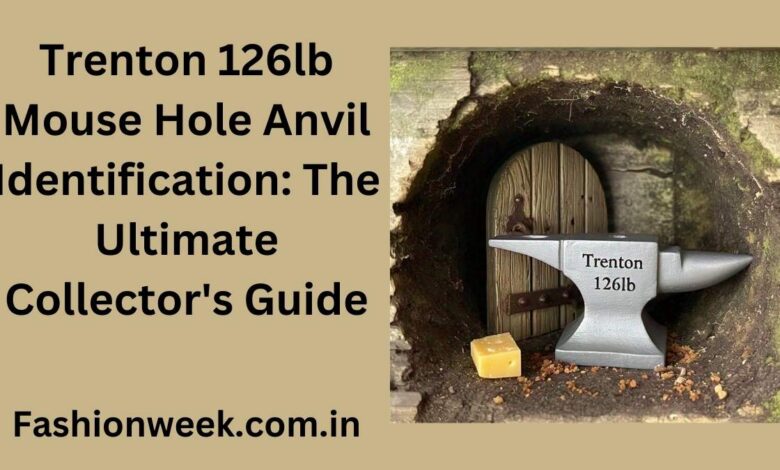Trenton 126lb Mouse Hole Anvil Identification: The Ultimate Collector’s Guide

Introduction
Finding an old anvil is like discovering a treasure chest. Among collectors and blacksmithing fans, the Trenton 126lb Mouse Hole Anvil Identification is one of the most talked-about finds. These anvils are known for their quality, strength, and rich history. But identifying them correctly can be tricky if you don’t know what to look for.
In this guide, we’ll walk you through the Trenton 126lb Mouse Hole Anvil Identification process step-by-step. Whether you’re a new collector, a history buff, or someone who just stumbled upon an old anvil in the garage, this article will help you. Let’s dig into the world of these legendary tools and learn how to spot a real gem!
What is a Trenton 126lb Mouse Hole Anvil?
The Trenton 126lb Mouse Hole Anvil Identification is one of the most famous brands made during the late 1800s and early 1900s. Built to last, these anvils were crafted mainly in Columbus, Ohio, by the Columbus Forge & Iron Company. They became known for their solid construction, perfect balance, and clean rebound.
The “126lb” refers to its weight — 126 pounds — which was a popular size for general blacksmithing work. The Mouse Hole part refers to a specific style and historical link to Mouse Hole Forge in England, where the anvil style originally gained fame. American manufacturers like Trenton adopted the strong, practical design and perfected it for industrial use.
Why Trenton Mouse Hole Anvils are Special
1. Exceptional Craftsmanship
Each Trenton anvil was forged carefully, with attention to detail. The steel face was welded onto a wrought iron body, creating a hard working surface that could take years of pounding without giving up.
2. Perfect for Blacksmiths
The 126lb size is ideal — not too heavy to move but sturdy enough for serious metalwork. That made it a favorite among blacksmiths, farriers, and toolmakers.
3. Rich History
Owning a Trenton Mouse Hole anvil is like owning a piece of industrial history. These anvils were essential tools during America’s booming manufacturing era.
How to Identify a Trenton 126lb Mouse Hole Anvil
Recognizing a real Trenton Mouse Hole anvil involves looking at several important features. Let’s break it down:
1. Look for the Trademark Stamp
The first thing to check is the stamp on the side of the anvil.
- “TRENTON” will be clearly marked inside a diamond-shaped border.
- The stamp is usually found just below the waist (middle part) of the anvil.
- The letters might be worn down if the anvil is very old, but with a good light or rubbing technique, you can still see it.
2. Check for Serial Numbers
Most Trenton anvils have a serial number punched into the foot under the horn or heel.
- The number can help date the anvil.
- Trenton anvils made between 1898 and 1950 used serial numbers.
- Example: If your anvil has a serial number like “48213,” it was probably made around the 1910s.
Tip:
You can cross-check the serial number with online Trenton serial number charts to estimate its production year.
3. Inspect the Weight Mark
Next, look for weight markings.
- Anvils often have the weight marked in pounds.
- 126lbs is considered an excellent working size and suggests the anvil was designed for serious use.
You may find markings like “126” near the foot or the side of the anvil.
4. Examine the Shape and Design
Trenton anvils have a distinct shape:
- A long, straight horn
- A clear separation between horn and body
- A flat face
- A well-defined step (where the horn meets the face)
If your anvil matches these design elements, it’s likely a Trenton.
5. Material and Build
- The faceplate is hardened tool steel.
- The body is wrought iron.
- You can often see slight forge welding lines where the steel face was bonded to the iron body.
Old forge welding signs add authenticity!
Common Mistakes When Identifying Trentons
Even experienced collectors sometimes make mistakes. Here’s what you need to avoid:
1. Confusing Mouse Hole Forge with Trenton
While they are similar, a true Mouse Hole Forge anvil is made in England. A Trenton Mouse Hole style is American, inspired by the English original.
Always look for the Trenton diamond stamp for confirmation.
2. Overestimating Value Based on Size Alone
Size matters, but condition and markings are much more important when judging anvil value. A beat-up 200lb anvil can be worth less than a pristine 126lb Trenton.
How to Value Your Trenton 126lb Mouse Hole Anvil
Now that you’ve identified your anvil, you might wonder how much it’s worth. Here’s a quick guide:
1. Condition
- Smooth face = Higher value
- No cracks or chips = More desirable
- Clear markings = Adds to the price
2. Rarity
Some serial number ranges are rarer than others.
Older anvils (pre-1900s) tend to fetch more money.
3. Market Demand
In recent years, blacksmithing, knife-making, and tool restoration hobbies have exploded. This means good anvils sell fast at high prices.
Average Price Range:
- Worn or damaged Trenton 126lb = $200–$400
- Good condition = $500–$800
- Excellent, collector-grade = $1000+
Where to Buy or Sell Trenton Anvils
You can find Trenton anvils at several places:
- Online Auctions (eBay, Etsy)
- Local Antique Shops
- Blacksmithing Groups on Facebook
- Farm Auctions and Estate Sales
If you’re selling, make sure to take clear photos of the logo, serial number, and any special features to attract serious buyers.
Tips for Restoring Your Anvil Safely
If your Trenton 126lb needs a little love, here’s how to clean it up without ruining its value:
- Use a wire brush and WD-40 to remove surface rust.
- Avoid grinding the face unless absolutely necessary.
- Oil the anvil lightly to protect against further rust.
- Leave old dings and character marks — they add to authenticity!
Conclusion
Identifying a real Trenton 126lb Mouse Hole anvil can feel like solving a fascinating mystery. With a careful eye and the tips in this guide, you’ll be able to spot the trademarks, serial numbers, and design details that reveal its true story.
Remember, each anvil carries the marks of time and labor, making it more than just a tool — it’s a piece of history. Whether you plan to use it for forging, display it proudly in your shop, or sell it to a collector, your Trenton anvil deserves respect and care.
FAQs About Trenton 126lb Mouse Hole Anvil Identification
Q1: How do I know if my anvil is a Trenton Mouse Hole?
Look for the Trenton diamond-shaped logo, a clear serial number, and typical Mouse Hole anvil features like a long horn and clear face.
Q2: Can I date my Trenton anvil exactly by the serial number?
Yes, approximately. By matching the serial number to published Trenton manufacturing records, you can find the year or decade it was made.
Q3: Is a 126lb anvil considered a good weight?
Absolutely! It’s one of the best working sizes for both beginner and advanced blacksmiths.
Q4: What should I avoid when cleaning an old Trenton anvil?
Avoid heavy grinding, welding repairs, or painting over the anvil, as these can lower its value significantly.
Q5: Are Trenton anvils better than other brands like Peter Wright or Hay Budden?
Each brand has its strengths, but Trenton anvils are widely praised for their durability, balance, and quality — making them highly sought after.

